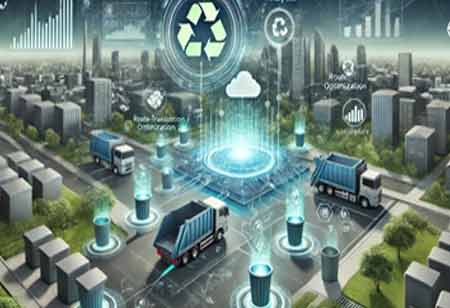Thank you for Subscribing to Environmental Business Review Weekly Brief
Smart Waste Solutions: Paving the Way for Sustainable Urban Environments
Data-driven waste managed services are redefining operational behavior, balancing innovation with infrastructure, and unveiling strategic opportunities across evolving environmental networks.

By
Environmental Business Review | Friday, October 31, 2025
Stay ahead of the industry with exclusive feature stories on the top companies, expert insights and the latest news delivered straight to your inbox. Subscribe today.
A silent shift is rippling through the infrastructure beneath urban life, one not marked by sweeping demolition or towering cranes, but by real-time signals, responsive containers, and the invisible intelligence of embedded systems. The rise of data-driven waste managed services is creating a distinct contour in modern environmental management. These solutions are no longer niche experiments. They now shape the way urban and regional environments coordinate resources, address capacity, and manage accountability. As systems become more interconnected, the waste sector is finding new language in data, new priorities in precision, and new depth in operational foresight.
Market Shifts Driving Intelligent Adaptation
The current market reflects a sharp departure from static collection models toward dynamic, integrated systems. Sensors embedded within collection assets no longer act as isolated data points. They form a neural layer of intelligence that allows operators to anticipate overflow, reroute collection, and adjust to community behavior patterns. Autonomous sorting units and AI-guided logistics platforms enhance material recovery accuracy and remove inefficiencies before they translate into downstream delays. What is emerging is a multi-tiered digital mesh that tracks, predicts, and responds. This transforms what was once linear waste disposal into a more circular, optimized system.
This shift is not only operational but also strategic. Remote monitoring enables optimized routing along with insights into contamination rates and stream composition. Micro recovery nodes are now being placed closer to waste origin points, allowing for flexible processing and reducing the carbon footprint of transport. While these may appear to be incremental enhancements, collectively they reveal a recalibrated industry. One that is less reactive and more refined, designed for rhythm rather than routine. The market appetite continues to grow for platforms offering customizable analytics, live dashboards, and predictive outputs. These tools empower stakeholders to make decisions with speed and contextual alignment.
Navigating Friction in Transition
Although the horizon appears promising, the current terrain is not without tension. One of the more pressing complications is the cost alignment between innovation and existing infrastructure. Many operators manage systems built on analog assumptions where interoperability between hardware and data platforms remains inconsistent. Upgrading legacy fleets or facilities with smart layers involves more than physical replacement. It requires internal training, operational redesign, and buy-in from often budget-constrained stakeholders.
Even with adaptive modules offering retrofitting potential, challenges persist. Data centralization efforts are often met with fragmentation when various departments, vendors, or municipalities follow divergent formats or platforms. This slows the ability to scale and share insights across networks. In parallel, digital security and privacy regulations add complexity, especially in densely managed zones. Data captured from sensors must adhere to high standards of confidentiality while maintaining operational usability.
The sector is responding to these challenges through inventive design strategies. Modular deployments and shared infrastructure models are gaining traction. Collaborative platforms that operate across jurisdictions are helping normalize data exchange without enforcing uniformity. Micro-deployments in selected areas allow operators to evaluate performance economically before committing to broad-scale integration. Workforce development is also taking shape, with new roles emerging to interpret system outputs rather than simply monitor them. These responses do not eliminate friction but reposition it as a design condition to be addressed with purpose.
Emerging Opportunities and Strategic Momentum
The growing infrastructure of data-driven waste systems reveals clear opportunities for stakeholders. Planners benefit from a new layer of predictive modeling that enhances capacity planning. This allows for smarter investments in collection points, processing facilities, and fleet allocation. Environmental regulators gain access to real-time reporting and audit trails that provide reliable insights. The result is improved strategy alignment based on actual behavioral patterns rather than theoretical assumptions.
Circular economy goals are now receiving technical reinforcement. Traceability ensures that recovered materials can be verified at each stage of their journey, supporting both transparency and compliance. Advancements are moving beyond data capture into intelligent orchestration. Urban waste data is being integrated with mobility and energy systems, leading to cross-sector benefits and more resilient city frameworks. This convergence turns waste from a logistical issue into a managed asset channel.
These developments offer measurable value. Stakeholders are beginning to recognize the strategic implications of digital stewardship. With accurate insight, cities and operators can shift from reactive models to systems of foresight, accountability, and environmental integrity. The investment landscape is also evolving. Support is aligning with platforms that can deliver operational clarity and long-term gains, rather than chasing novelty.
A growing number of urban environments now treat waste intelligence as critical infrastructure. Predictive collection, localized processing, and AI-led resource flow management are no longer conceptual frameworks. They are active features that define how service delivery is evolving. With clear momentum building across policy, practice, and investment channels, the sector is reaching a point where performance and purpose are becoming inseparable.





